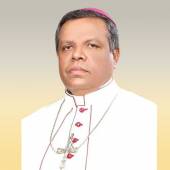Unemployment, economic inequality drive people to migration, say Indian bishops

Unemployment and economic inequality force young people to migrate massively, says the Indian bishops’ conference.
The Commission for Migrants of the Latin Catholic Bishops' Conference of India (CCBI) has said that rising unemployment and economic inequality in India are forcing young people to migrate on a large scale, leading to a serious socio-economic situation.
The National Conference of the Commission for Migrants, for two days (May 11-12) at the Shanti Sadan Pastoral Center in Goa, analyzed issues related to the migrants in India.
The event was held in Goa, western India to mark the 400th anniversary of the canonization of Francis Xavier.
Fifty percent of Indian youth have lost their jobs since the Covid-19 pandemic. Unemployment is increasing by more than eight percent every year. No appointments are made for the vacant posts in the public sector.
The situation of unorganized workers, including domestic and construction workers, is deplorable, the conference assessed.
CCBI President Archbishop Filipe Neri Ferrao inaugurated the conference.
The prelate pointed out that St. Francis Xavier was a migrant and took care of the poor and needy. Saint Joseph Vaz born in Goa went to Sri Lanka and served the sick and poor people there.
Archbishop Victor Henry Thakur, the chairman of the Commission for Migrants said, “Migrant brothers and sisters need our listening year more than anything.”
Pastoral ministry to the migrants is not an option but a demand. Migration is a normal process it cannot stop, he added.
Lourdes Baptista briefed the participants on the recent instruction of Pastoral Orientations on Intercultural Migrant Ministry prepared by the Dicastery for Promoting Integral Human Development, Vatican.
It says “Develop a Culture of Encounter” in complementing, enriching and reciprocally illuminating one another.
He further said that the document recognizes that every single baptized person in the Church is a full member of it wherever he or she may be. Embracing the arrival of Catholic individuals and integrating them as citizens and equal members. As well as be a missionary Church–reach out to those needing help–discarded, ostracized, oppressed. Be an inclusive Church. Love unconditionally. The church has the responsibility to care for everyone who is created by God.
The Commission for Migrants was created in 2019.
Father Jaison Vadassery, the executive secretary said that this commission has its Diocesans counterparts in the majority of the regions in India.
He insisted that the migrants need to be accompanied for their spiritual and economic needs. Networking with all those who are engaged in caring for the migrants is the need of time.
The commission has taken birth at a time when the whole world was gripped by a pandemic. The church contributed the immediate support as far as it she could. Even now the commission for migrants reaches out to them with dry food kits as many have lost their livelihood.
Father Albert Thambi Durai, a participant said the plight of the migrants is many, the Catholic Church is an organized body and working together to help the migrants will bring a sizeable change in each diocese.
Another participant said there have been many mishappenings at the destinations unfortunately these issues are not reported by the media.
One such incident happened on May 7 when Daringabadi, a village in the Kandhamal district of Odisha, eastern India, received the body of Chittaranjan Nayak (34).
He was on his way to the southern Indian state of Kerala with his two friends in search of work. He got sick near Vijayawada, got down from the train at Vijayawada and was admitted into Government General Hospital, Vijayawada, where he struggled with life for two days and finally breathed his last. He left behind two small children and the widow. He was the only breadwinner of the family.
Archbishop Elias Gonsalves, the vice-chairman of the commission emphasized network collaboration with all those who are working for the welfare of the migrants.
Compartmentalized work brings results to a small group whereas collaboration can make difference in the lives of the migrants, he said.
The conference formulated an action plan to be implemented at the regional and diocesan levels for the next five years.
This meeting was called to think together to come out with plans for the regions to better the service to migrants.
It would sensitize the clergy, religious and Catholics on the importance of an inclusive church in every diocese.
Data collection is to be done to address the needs of the migrants, and linkages to assist them with education, job and other needs.
Pope Francis in his messages exhorts saying, “Everyone to care for the migrants as they are our brothers and sisters. Now the church is mandated to look out to help the migrants who are distressed, displaced and exploited.”
The Federation of Asian Bishops' Conferences (FABC) Chairman Dr. Alwyn D’Silva spoke to the participants on the need for the different commissions in the dioceses to collaborate and work for the cause of the needy.
He said, “Saint Mother Theresa of Calcutta identified the need of the abandoned, orphaned and the like. The issues of the migrants can be understood only when we visit and listen to them.”
The participants will periodically review the progress of the commitment taken and will focus on ‘Develop a Culture of Encounter’ inconsonance with Synodality. - Rani Punnaserril
Radio Veritas Asia (RVA), a media platform of the Catholic Church, aims to share Christ. RVA started in 1969 as a continental Catholic radio station to serve Asian countries in their respective local language, thus earning the tag “the Voice of Asian Christianity.” Responding to the emerging context, RVA embraced media platforms to connect with the global Asian audience via its 21 language websites and various social media platforms.














